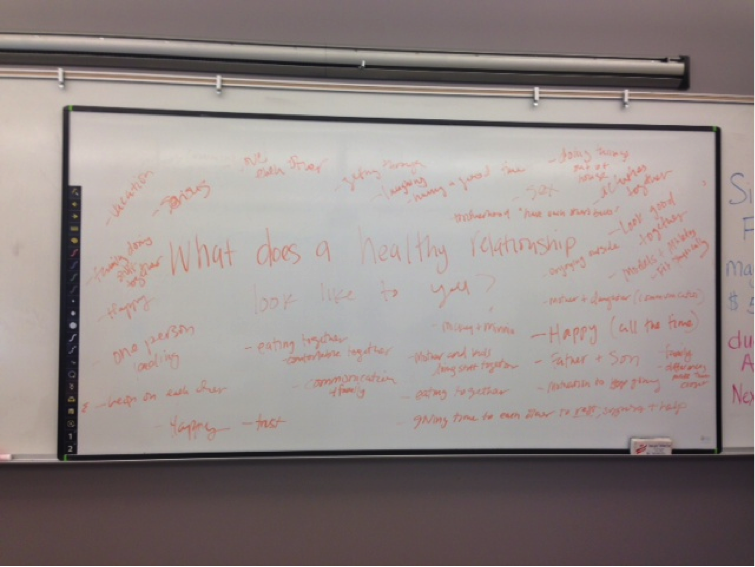Greetings to the aea365 community. We are Kelly Washburn and Julie Carpineto from The Institute for Community Health in Cambridge, MA. We are the local evaluators of an urban high school-based teen pregnancy prevention program in Greater Boston. We would like to share an example of a creative evaluation project developed with this program.
Over 90 high students participated in a three-series collage evaluation project. This resource was developed in collaboration with our program partners, who wanted to find new and creative ways to involve youth in their program evaluation.
Lesson Learned: Drawing from the principles of Photovoice and other arts-based evaluation techniques; we aimed to engage participants in a discussion of a major theme addressed in the program, healthy relationships. We collaborated with the program coordinator to come up with the evaluation question. “What does a healthy relationship look like to you? This question was chosen for a couple of reasons: the first being the timing of the evaluation with the alignment of the program sessions. Students had recently completed a series of classroom sessions focused on healthy and unhealthy relationships, and we were interested in understanding how those sessions shaped their vision of healthy relationships. Furthermore, data from focus groups conducted in previous years revealed that the relationship sessions were those that stuck out to students as having had the most impact on them personally. By asking this question, we were able to gain a more in-depth understanding of students’ opinions about this topic.
Students were asked to individually respond to this question by pulling images from magazines. They were then led in a large group discussion about why they chose their images. Looking at their chosen images, students were asked to reflect on their thoughts, feelings, perceptions and experiences of relationships.
Students were then asked to work in small groups to attach their images to form a larger collective collage poster.
These posters are visual representations of the student’s responses to this question.
The final phase of this project will include individual interviews with participating students to gather additional information about the process and their experience as program participants.
Lessons Learned:
- Magazine selection should be a part of initial planning.
- Chose a diverse range of magazines. Make sure your selection of images is representative of your population!
Hot Tip:
- This project can be done with a small budget, limited time and with almost any participant population.
- This project is a fun and creative way to engage young people in evaluation.
Cool Trick: If available, take notes from the large discussion on a large white board. This serves as another visual representation and can help students develop their collages.
Do you have questions, concerns, kudos, or content to extend this aea365 contribution? Please add them in the comments section for this post on the aea365 webpage so that we may enrich our community of practice. Would you like to submit an aea365 Tip? Please send a note of interest to aea365@eval.org . aea365 is sponsored by the American Evaluation Association and provides a Tip-a-Day by and for evaluators.




Similar to Lynn Baum – I am wondering about the analysis process as well. Thank you! Grace
I was very interested in this approach to evaluation and would like to know more about the analysis process. Was a rubric created to assess the collages? Did you video the discussions? What were your measures for success? Thank you for any information on this stage of the evaluation.
Lynn Baum